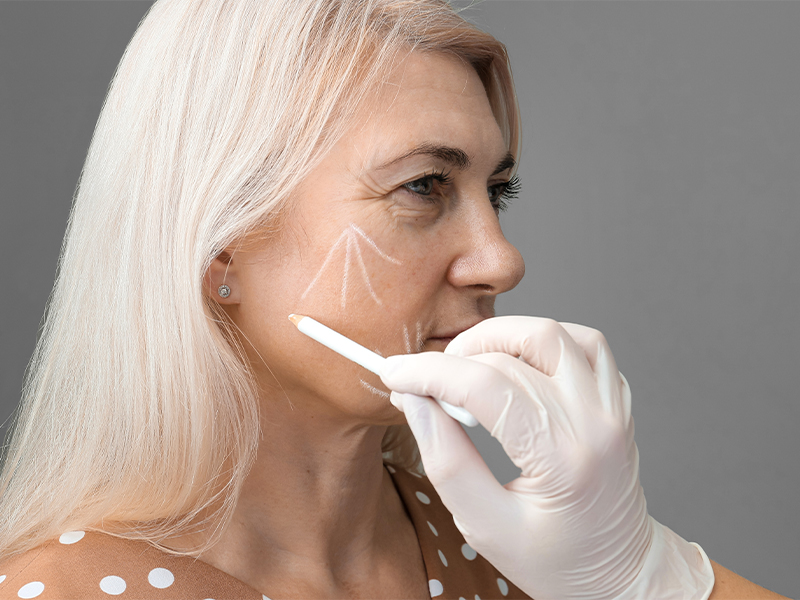It used to be clear what a facelift was: a surgical operation under anaesthesia that made incisions near the hairline, then pulled back and excised loose skin to take ten years off your face. Most of all, a facelift was something I would never, ever think of doing. And then I met DR WONG CHIN HO of W Aesthetic Plastic Surgery in Singapore, who told me about deep-plane facelift. He made me think again. Dr Wong did his fellowship in face-lifting, and he lifts a lot of faces. Some years ago, he skilfully excised three small growths from my face (the legacy of sun damage in my foolish youth), so I’ve had personal experience of his incredibly fine stitching technique. He discusses his work in more detail here.

What can a patient expect from a facelift?
The decision to have a facelift might be one of the most significant decisions that you will make. Many patients instinctively know when the time has come for them.
I like to put things into perspective and to be clear about what is possible in terms of the degree of improvement that can be achieved, given his or her individual skin quality, skeletal structure and the severity of ageing-related changes.
I would also show before and after photographs of previous cases. These give patients a better idea of the results they can expect.
Who is a good candidate for a facelift?
Someone looking for a profound rejuvenation. But, if you’re not keen on surgery and will be satisfied with a very subtle result, non-invasive techniques involving high-tech radiofrequency and ultrasound can tighten and rejuvenate the skin to some extent.
Non-invasive methods don’t work for the jowls, as you can see by manually lifting your own cheeks. There’s excess skin above it, and that needs to be removed.
To remove sagging jowls and really get a fresh appearance, however, takes a surgical facelift. Ageing is not just a question of sagging, either. There’s also an issue of facial shape. The youthful shape is triangular or heart-shaped; now, with jowls appearing, it becomes squarish.
What sort of facelift do you perform?
I do what is called a deep-plane or composite facelift, which addresses both the skin layer and the layer below it. It gives a completely natural result – you simply look like your younger self.
Because the tightening is done in the support layer of the skin, rather than in the skin itself, we avoid the stigma of a traditional facelift – that “wind-tunnel” look. Now, with our better understanding of the anatomy of the face, we are able to achieve much better results, and just as safely.
Nowadays, the incidence of nerve injury with the composite technique is the same as it is with traditional facelifts, just one percent.
The result is also more natural, and the effect is longer-lasting.
Who developed the deep-plane facelift?
The deep-plane facelift was first described over 30 years ago by Dr Sam Hamra in Dallas, who achieved superb results. In those days, however, the technique was not popular, because it was considered dangerous. Since it works at the deeper plane where you find the facial nerves, there’s a real risk of nerve injury.
The pioneer in the understanding of facial anatomy – and also my mentor – is Dr Brian Mendelssohn from Melbourne. Together, he and I contributed a chapter on Facial Soft Tissue Spaces for the third edition of Neligan’s important work, Plastic Surgery Principles.
With this understanding, we can get into those facial spaces safely with minimal risk to the patient. The risk of nerve injury associated with the new, improved composite technique is the same as it is with other facelift techniques: one to two percent.

Are there any differences when performing facelifts for Caucasian and Asian patients?
Profound rejuvenation results may be achieved for Caucasian and Asian patients alike with the deep-plane technique. However, because of differences in tissue characteristics and skeletal anatomy, technical adjustments are required to deliver good outcomes.
Caucasian skin is lighter, thinner and more delicate than Asian skin. We can therefore drape it more effectively and recovery is generally quicker. Asian patients require more extensive release to the front of the face in order to lift their thicker, heavier facial soft tissues.
To the point: What would you recommend for me?
You’re lucky to have hardly any eye bags. You have a great skeletal structure and a good jawline and cheekbones, so you would achieve a great result with the composite facelift. I would recommend the full facelift – and for you, we could use the short scar technique.
Another component of ageing is deflation. To restore volume around the eyes and the forehead, I would harvest some fat from elsewhere on the body, and graft it into the sunken areas to re-volumise them. This “lift and fill” approach is the essence of the modern facelift.
When is the right time to have one?
If you have it done while your skin is still in good condition – before you obviously need a lift – you will achieve the best results. Once ageing is advanced, it’s more difficult to get a great outcome.
Only the patient knows when the time is right. Often, her decision is triggered by a life event such as a daughter getting married, or perhaps the death of a spouse. I always say that the main purpose of this surgery is not to please the eye, but to uplift the soul.
Deep-Plane Facelift Cost: From $30,000 to $36,000
Downtime: About three weeks
Duration of effect: Lasting
Dr Wong Chin Ho answers more questions on facelifts in Singapore
What do first-time facelift clients tend to worry about the most?
The most common worry is the recovery time for a facelift. Other concerns include swelling and bruising, though these can be minimised with modern techniques and meticulous surgery and wound care. In general, most patients can return to work in about three weeks.
Patients also worry about not looking “natural” after cosmetic surgery. However, with the composite facelift, the results are very natural with no tell-tale signs of surgery.
Are there certain markers around whether a client may be a suitable or unsuitable candidate for a facelift?
A patient’s general health is important and should be optimal before elective plastic surgery. Smokers generally take longer to heal from incisions – they’re advised to stop smoking before surgery. Patients on blood thinners like aspirin or Plavix should stop these medications (if their health condition allows) at least a week before the surgery.
How long is the recovery time for some of your more popular procedures?
For fat grafting, the recovery time is about a week. However, for a composite facelift, it will take about three to four weeks, at a minimum.

Each person is different, of course, but how long does the procedure last on average?
A composite facelift will easily last five to 10 years.
How noticeable is the scarring?
The incisions are discreetly hidden in the hairline and skin creases, and after several months are no longer conspicuous.
Which areas heal better when it comes to scarring?
Incisions on the face generally heal much better than incisions on the body.
Which areas on the face are easier to work on?
The most profound improvement with the composite facelift is in the jowls, jawline and the neck. These are also areas that are the primary concern for many patients presenting for facial rejuvenation.
What ancillary procedures are done together with a facelift?
Modern surgical rejuvenation focuses on delivering natural and lasting effects. The composite facelift is a type of deep-plane procedure that tightens the support layer of the face. This restores the facial tissue that has “sagged” with ageing without giving a tight and unnatural look.
In addition to the tightening, there is significant loss of facial volume. At the time of the composite facelift, facial fat grafting – using your own fat – is performed to selectively restore fullness or volume. This combination of tightening, combined with composite facelift and restoration of facial fullness with fat grafting, delivers the most natural and harmonious facial rejuvenation.
Some patients may also have issues with droopy eyelids, droopy brows and eye bags. These may be addressed with eyelid surgery or brow lifts at the same time as the procedure.
W Aesthetic Plastic Surgery
#06-28/29 Mount Elizabeth Novena Specialist Centre, 38 Irrawaddy Road
6570 2528 | waesthetics.com
We hope you found this article on facelifts informative! Ready for your next facial? Click here.





